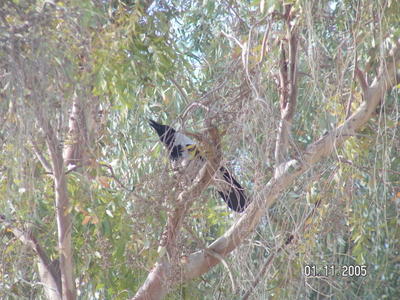
Mesopotamian Crow Calling - LSA Anaconda, January 2005
LTC Bob near Baghdad has only a couple more months until he redeploys back home. He has a few more posts up on Silflay Hraka with some great pictures.
The picture of the male black francolin may actually be one of the 2 individuals I saw at Camp Victory last year. He also has some pictures of francolin chicks and a post on Spur-winged Plover with pictures of plover chicks and a black-winged stilt chick. His latest post is on the Collared Pratincole and an Indian Roller post is forthcoming. Last month LTC Bob wrote about the Golden Jackal.
In other birding news, The Field Guide to the Birds of the Middle East, the guide I used in Iraq is being published in Arabic in February of 2006. This is a very significant event in my opinion. Just as the Peterson Field Guides spawned a generation of birders in the US, I hope that this book will do the same in the Middle East. It would be a great thing if each school in Iraq could have a copy to inspire young naturalists.
On another subject, I've been reading the very interesting journal of Andrew Cote, a guy from Connecticut who just came back from a trip to Iraq in August. He was in Iraq to train farmers in modern techniques of beekeeping. Here's a story about him in a local paper.
Reading through the entries I learned that some of the beekeepers in the Kurdish north have problems with European Bee-eaters for a few weeks during migration when the birds gorge themselves on Honeybees. In one village one of the beekeepers even produced the carcass of a bee-eater. The picture is on the website in his gallery (I can't seem to link to it). There are also interesting pictures of the traditional beehives which are made of straw and mud. In the fall these hives are cracked open like a giant nut to get the honey out.
The whole site is fascinating. I learned that, as in the US, the dreaded Varroa Mite has decimated the honeybee population, decreasing it perhaps 90%. Other problems are the Oriental Hornets, gigantic orange and yellow beasts that can tear up a hive. I dispatched quite a few of them when I was in Iraq. Having an insect net came in handy when it was bug killing time. I just read a story this week about how honeybees sometimes kill one of this hornet's even larger relatives, the Asian Giant Hornet, by cooking it to death. The bees swarm over a hornet and form a ball around the insect. They beat their wings furiously creating enough heat to kill the hornet. They actually come only a few degrees from cooking themselves. Both Oriental and Giant Hornets can destroy a large hive. They crush the honeybees in their mandibles one after another until the bees are all dead. They then take away the juicy larvae in the combs.
After reading through all the entries and thinking about my Father's hive he had while we were growing up I felt like beekeeping might be something I might like to try when I have a little more free time.
Doing a bit of research I found that the clay and straw hives made excellent weapons in the past. A kind of ready-made bee grenade that could be dropped on the enemy. Here's an entry from a book called Robbing Bees: A biography of honey by Holley Bishop published earlier this year describing such a use in the battle of Hatra in Iraq.
Before sophisticated box hives were invented, bees kept in twig, straw or clay vessels of various sizes were adapted as weapons. Bee grenades could be hurled through the air or dropped on enemies. By the time they reached their target, the projected bees were
outraged, ready to explode in a fury of stings. In book III of his History
Herodian describes the second century seige of Hatra, in modern-day Iraq, and
the use of bees as weapons.
Every kind of seige engine was used against the walls (of the city) and no technique of seige operation was left untried. But the people of Hatra rigorously defended themselves by firing down missles and stones onto the army of Severus below and causing them a good deal of damage. They made clay containers filled with little flying insects that had poisonous
stings, which were then fired off. When the missiles fell onto Severus’ army, the insects crawled into the eyes and exposed parts of the skin of the soldiers and stung them causing severe injuries.
1 comment:
If you would like to obtain a great deal from this piece of writing
then you have to apply such strategies to your won webpage.
Here is my web site http://www.xxxpornovideo.net/
Post a Comment